Header image courtesy of Julien Soleil
Most of us aspire to do a big ride at some point during our lives as gravel riders. But everyone’s definition of ‘big’ differs somewhat. It might be that 100 km or 200 km is as big as you imagine. For Wiebke Lühmann though big is a relative term. During 2024 she rode from her home in Germany down the west coast of Africa to reach the Cape of Good Hope, a total distance of over 20,000 km. We chatted with her recently to find out what makes her tick.
“I wanted to see how far I could ride in thirty days, so I used up all of my holiday allowance in one go and rode from Hamburg, Germany to the North Cape in Norway, a total distance of 3500km.”
Chatting with long-distance bikepackers and ultra-distance racers is always a pretty eye-opening experience. They seem so ‘normal’ when you first start talking to them, but then you realise that despite appearances, they are quite clearly superhumans in disguise. Wiebke Lühmann fits this description exactly. Understandably when we chatted she sounded a little tired, but apart from that there was nothing to make you think she had just got back from bikepacking over 20,000 km!
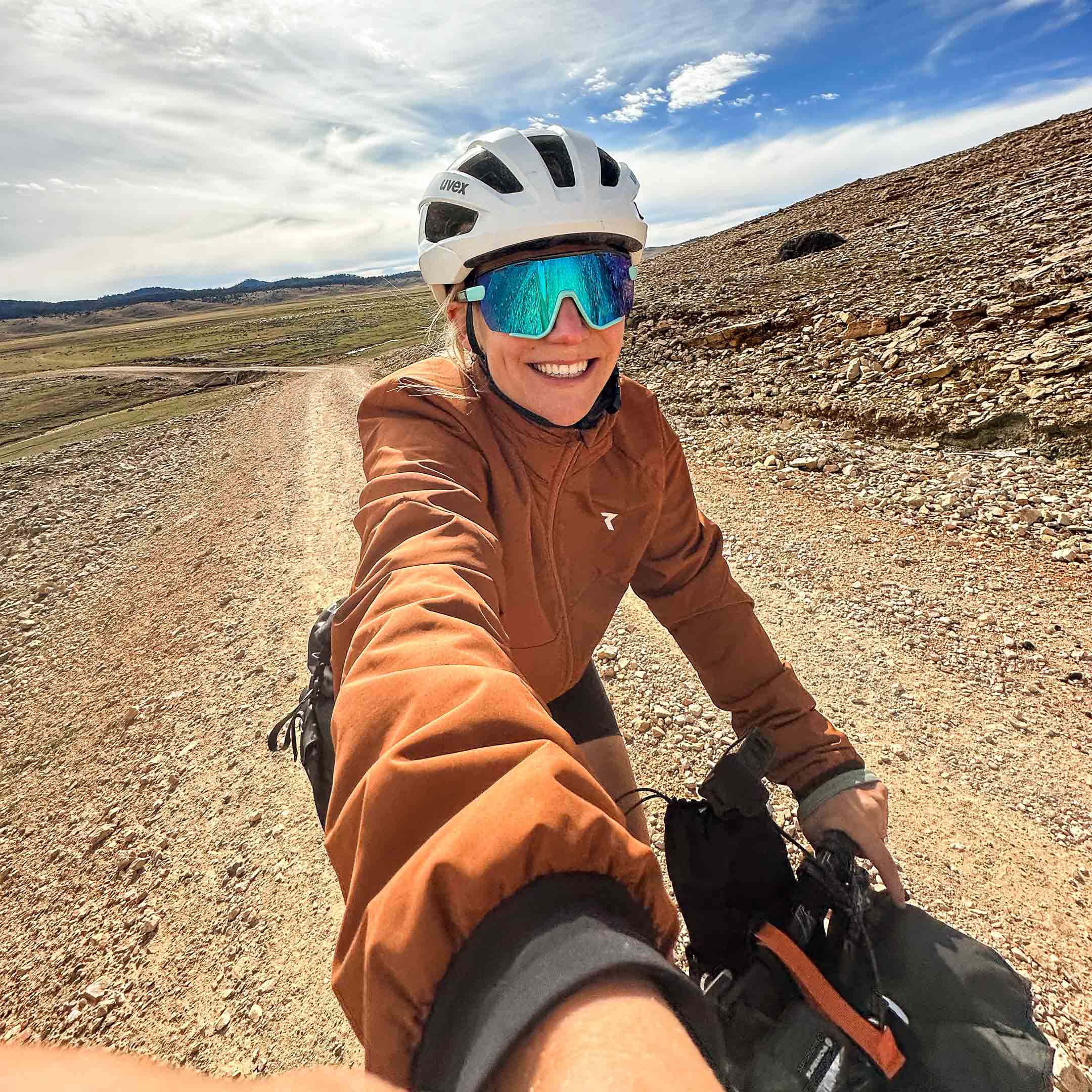
We started off by asking her to introduce herself to the Gravel Union audience. “I’m a bikepacker and gravel rider from Germany. I started cycling almost ten years ago and I started content creating four years ago. Before all of this, I used my bike for commuting and then I got into road biking. I used to work in a bike shop, where I didn’t earn any money, but I did earn myself a bike. I started my first trip in South America and what inspired me the most were the women I saw at a local bike race. Before that I thought that cycling was only for men. Everyone I knew who were into cycling were men, so by seeing these women it made me realise that I also wanted to be fast and cool on a fast road bike. At that time I was studying - I have a master’s degree in business education and English, so I could become a teacher but now I’m working in marketing. I really love long distance adventures and I live in Freiburg which can be considered the German version of Girona, but with less famous people or pro-riders!”
“I just put bags on my bike and took it on all sorts of roads.”
An obvious follow-up question was how did Wiebke first get into gravel riding? “I was working at 8bar bikes in Berlin – it’s quite niche and they used to be really into fixed gear riding, but now they’ve got into gravel riding. I got my first gravel bike from them which I then took straight away to South America. I guess I moved on [to gravel] from bike touring (with panniers) where I didn’t really know what I was doing – I just put bags on my bike and took it on all sorts of roads. Then gravel riding boomed and I got into it straight away.”
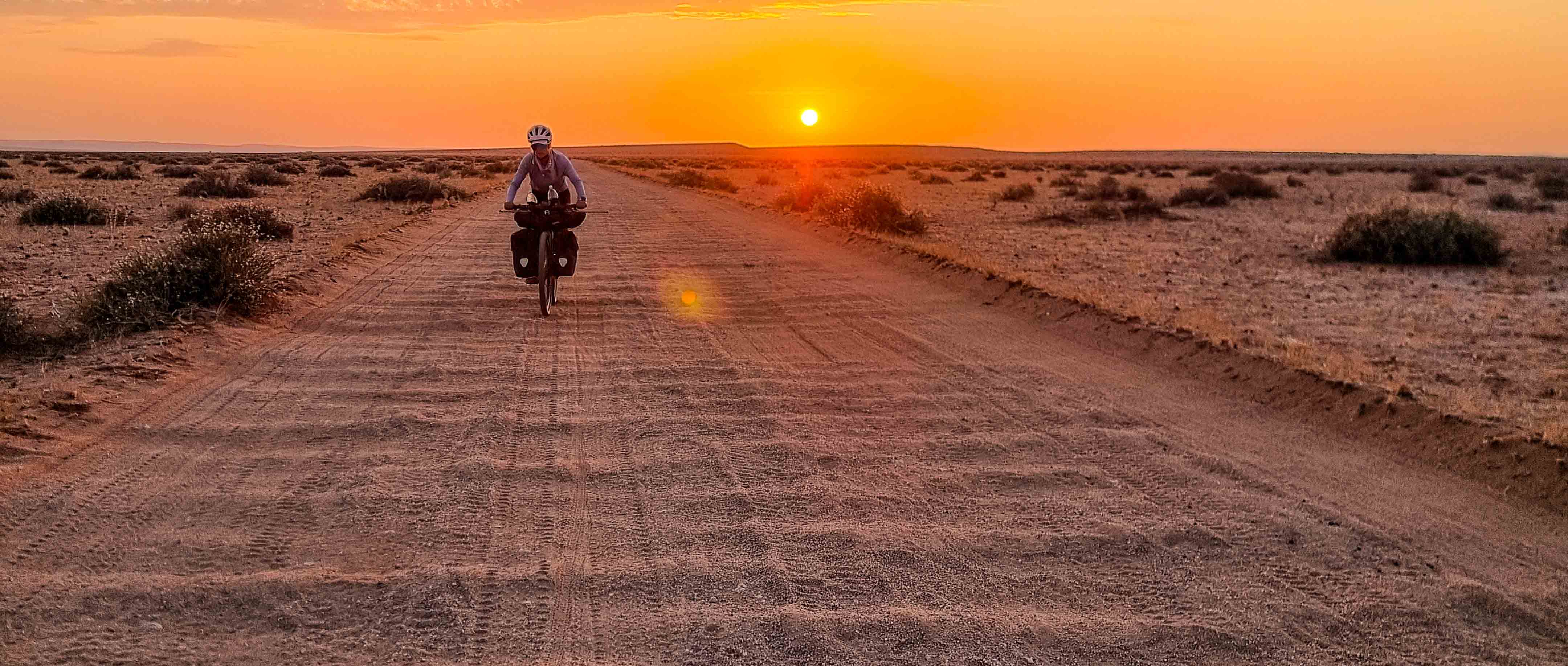
Having found out more about Wiebke’s history as a cyclist, we asked her next about what inspired her to start travelling in the first place? “When I was six or seven years old, my parents sent my twin sister and I to a church camp choir vacation somewhere and we stayed for two weeks even though we were really young. We did plenty of other trips away from home, with youth groups or friends and then when I was around 16, I spent a year abroad in the USA. It was one whole year without seeing my family which was pretty difficult. At that time we had access to Skype, but it still was pretty hard but it opened the door to being in a place for a longer period of time. It made me realise that it was not necessary to have to spend your vacations in a hotel and then come back home – you could stay with locals and adapt to whatever was around you. My parents really liked to have independent girls who could go out into the world and speak for themselves. In Germany, it’s also pretty common to go and travel after you finish your high school degree.”
“It was a really good experience and made me realise that long trips travelling by bike was something that you could actually do.”
“In 2019 I travelled around South America for seven months. In total I rode more than 7000km and climbed over 75,000m. I didn’t really have a fixed plan, but I wanted to learn Spanish, so that was a big impetus. I travelled first in Colombia, then on to Peru, Bolivia, Chile, Argentina and finally Brazil. I didn’t only learn Spanish but I also learned more about the bikepacking culture, found out more about the community. It wasn’t a big thing before, but after this trip it kind of became my life! It was a really good experience and made me realise that long trips travelling by bike was something that you could actually do. During this period, I decided that I wanted to go on a long trip by bike and decided to do this after my studies.”
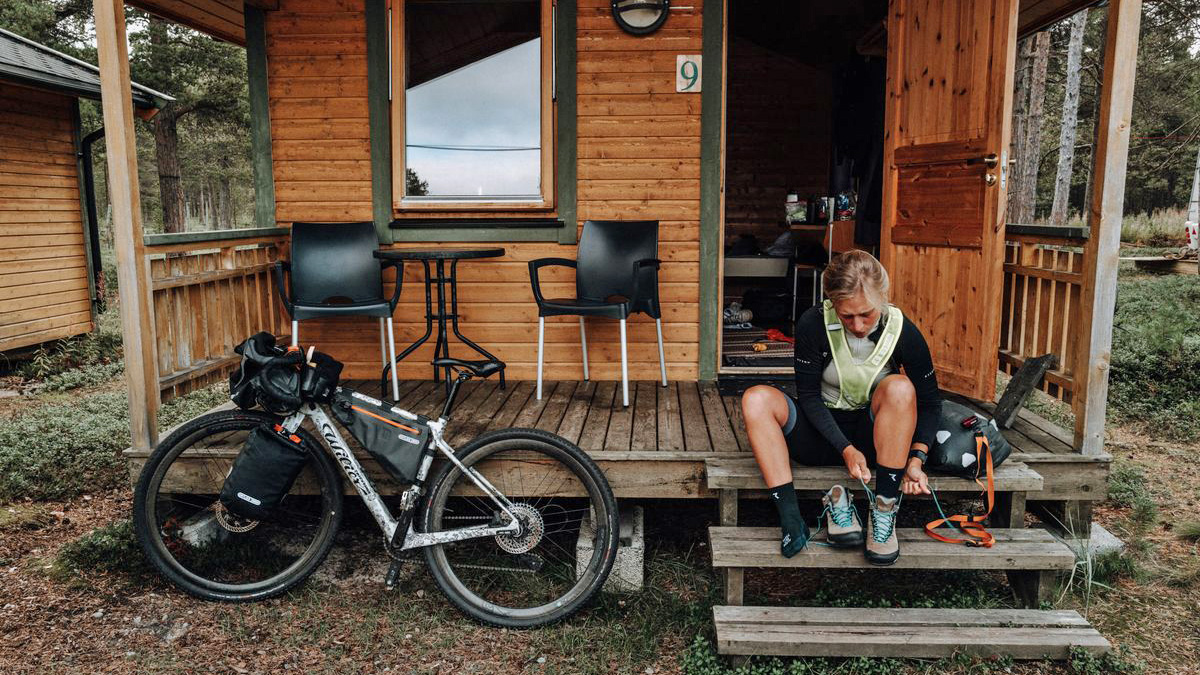
Image courtesy of Fabienne Engel
After a gap of a few years, partially caused by the arrival of the Covid19 pandemic, Wiebke made plans for another long-distance cycling trip, but this time her focus was Europe. “In 2022 I had a full-time job, but I had thirty days of vacation for the year. I decided to take all of them in one go and I wanted to see how far it was possible to ride in that time. I had heard about the beautiful scenery of the North Cape in Norway and I figured that I could make it in the time I had available. The scenery was absolutely stunning and I fell in love even more with wild camping, being around less people, getting out there into nature. I could set my own pace and be fully self-supported. It was a really fast and light project and also it was also my first movie project, which I planned together with my friend Fabi. I learned a lot about the movie making process, but also about the trip itself. It was half the distance of my South America trip, but in only 30 days. It showed me that I could move the limit again and do a trip in a different style. I rode on average 120km per day, which considering the winds and how hilly the route is, was pretty good. Along the way, I already thought about riding to the Cape of Good Hope, or riding south for the next trip. From Europe we are neighbours with Africa – it’s just 30 minutes ferry ride at the closest point and you can basically reach the other cape by going overland. So even in 2022, it was already in the back of mind."
“I wanted to cross a continent and also to ride the whole of the Atlantic Coast.”
We asked Wiebke what her timescale had been – was she initially considering her Africa project as some distant, far-off goal or more imminently? “I was thinking that I would do it during the year when I turned 30 which was 2024. I thought that having a five year gap between my two big trips was the right length of time. 2023 was just a ‘normal’ year where I was working and going to events which I really enjoyed – I wanted to be more part of the community and to not be away all of the time. It’s really tiring to always to be away, to always be with no people. I also really enjoy working on my friendships and spending time with my family. There are so many people in my life that I don’t want to miss for too long.”
Next we moved on discussing Wiebke’s big trip – her 20,000km trip down the west coast of Africa. An obvious first question – did she choose a route which finished at a Cape so she could make the overall journey Cape-to-Cape or was there some other reason? “It was a conscious decision. I wanted to cross a continent and also to ride the whole of the Atlantic Coast. I haven’t quite done the whole journey, as I’m missing a section from Hamburg to Bordeaux, but I will do this in summer.”
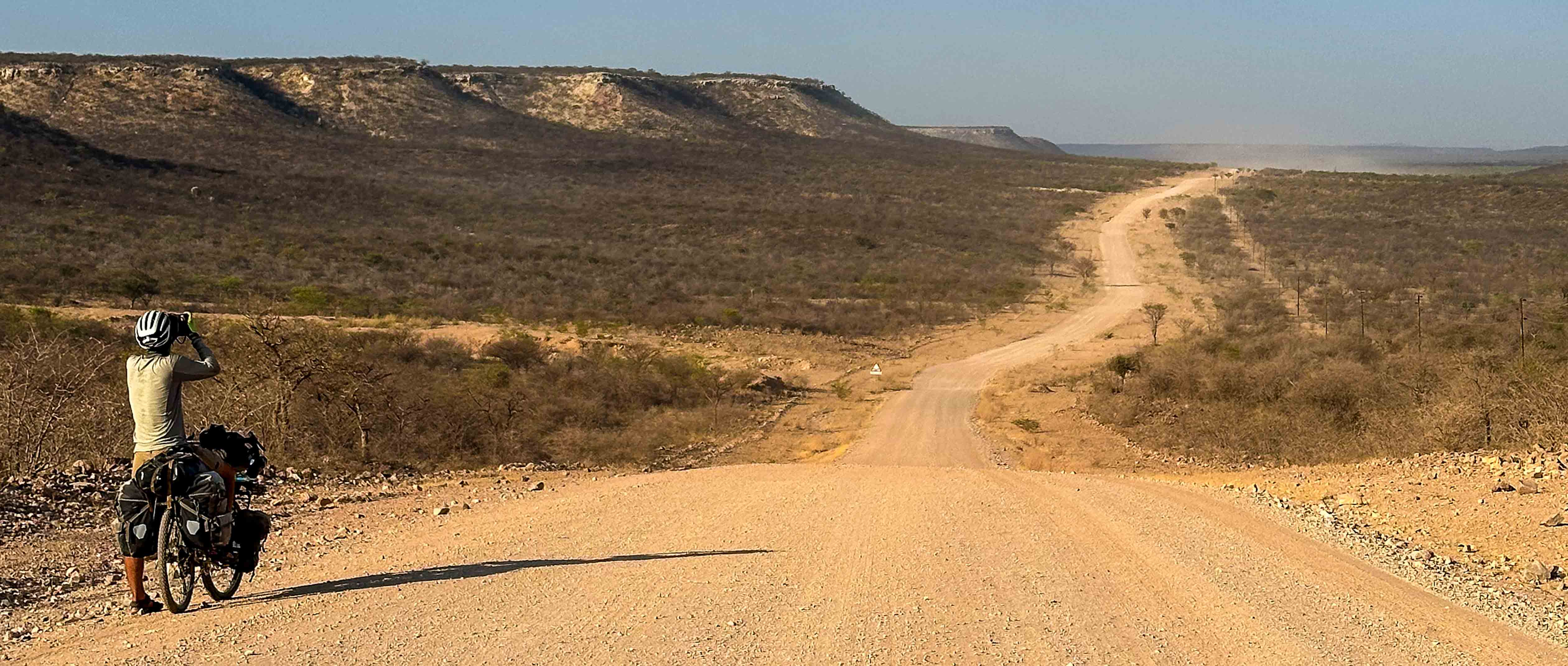
Wiebke went on to explain why she had chosen to go down the west coast “The western route is the only viable option right now, because of the ongoing war in Sudan. It means you cannot cross Africa by land on the other side. The eastern route is shorter, but at the minute everyone I know has had to overfly Sudan. At some point I would like to see the east too, as I think it’s beautiful. One of the things I love the most is getting to know a place. It’s great to have visited, to know where it is on the map, so that when you see it on the news, you can link it to your experience and to grow your world knowledge. For me, Africa was such a blind spot that it was invaluable to actually go there, rather than to just read about it or hear about it from other people. I wanted to find out about it for myself.”
In her blog, Wiebke talks about concept of “the adventure starts here” where the next section of your journey (as opposed to where you currently are) will be more difficult/risky/problematic. We asked her whether she ever did feel this at any point on her journey? “I never felt unsafe that’s for sure. People assume that they can read your feelings or read your anxieties, but for me it was always just another step. I always focussed only on the next country (or even just on the next day). It doesn’t help if people tell me ‘just wait for two months, because then it will be really hardcore.’ Sometimes a destination can be ‘hardcore’ for a different reason – if you ate something that didn’t agree with your tummy for example. Overall I never felt unsafe and in fact, I felt safer and safer as my journey went on, because my experience really helped me to make better decisions, to trust myself better, to know my way, to know how to talk, to know how to ask for help, to know where to sleep. Personal experience, in my view, is better than just getting advice from other people.”
“To research all of this beforehand is basically impossible – you just have to go and see what it’s actually like.”
We asked next about the research she did before she set off “It’s not possible to know every detail, but what I did do is to research all of the entry and visa regulations. Was it necessary to have a second passport for example? I read that for some countries you needed to send your passport to the embassy in your own country, so you would need to have a second one with you. In the end, I didn’t really need it as I could apply for all the visas along the way. The most research I did was for Nigeria as that’s considered to be very unstable and it has a higher crime rate than many other west African countries (and has had for the last twenty years). The countries from Senegal down to Benin felt very safe and calm. There is great variation on how developed different countries are and you do feel changes, but to research all of this beforehand is basically impossible – you just have to go and see what it’s actually like. I also thought that if you do too much research you perhaps don’t enjoy the adventure as much. When it comes to things like accommodation, I don’t generally book things in advance, I just show up and this seemed to work pretty well. I did do lots of reading of other travel blogs and it’s one of the reasons that I write a blog, so that people can find out information and can reassure themselves that a specific place is possible right now (or that it has been possible recently)."
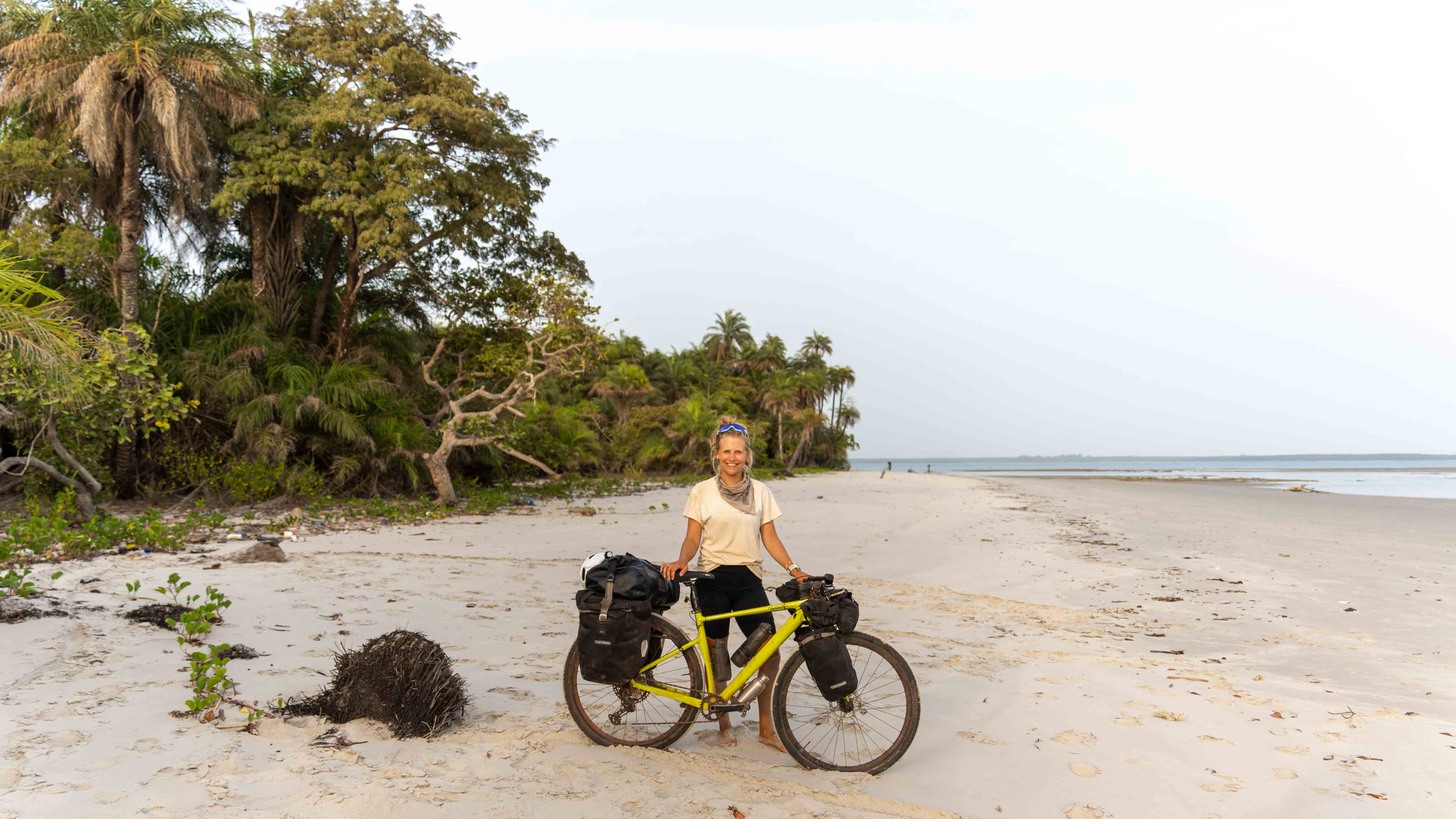
With a journey of 20,000km Wiebke would have experienced an incredibly diverse range of countries, geography, people, cultures. We asked her whether she had a favourite, assuming it would be quite hard for her to choose, but she answered without hesitation. “In West Africa, it was Guinea & Bissau. It’s a very tiny country between Senegal and Guinea, with amazing national parks which are protected, beautiful islands with white sandy beaches and very friendly locals. I had a bit of a break there as I needed to apply for my next visa. But then also Namibia, which is much further south was amazing. The landscapes are beautiful and it has a totally different climate.“
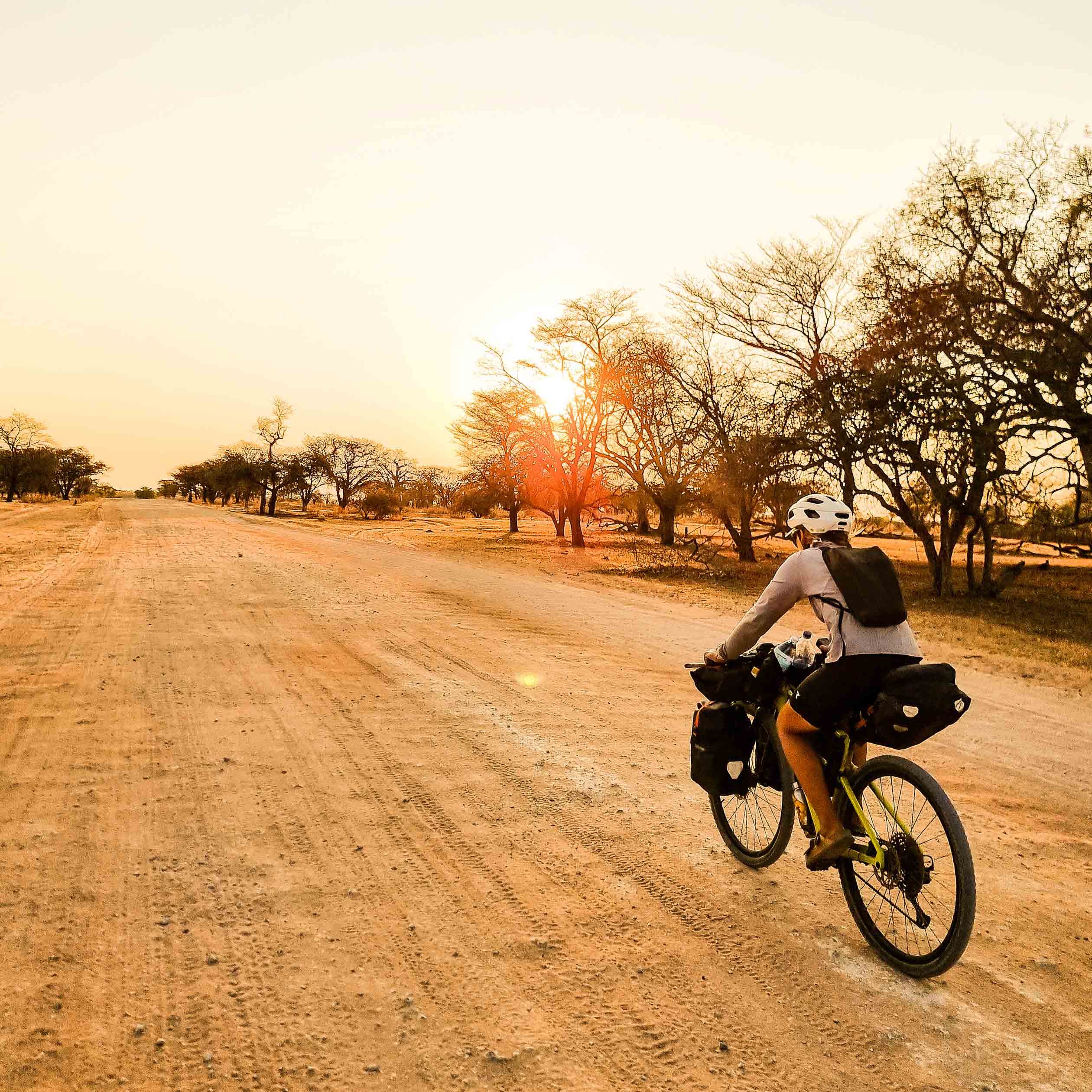
Anyone who has done any kind of long trip (sometimes even shorter trips too) can feel pretty miserable when they get home afterwards. We asked Wiebke how it felt coming back to “normal” life after her trip and did she try anything to help her feel a little less discombobulated when she got home? “Even having been home for five weeks now, it still feels like a big shock. Because I’ve travelled a lot before, I’m kind of used to it and I didn’t have high hopes for having the best time of my life when I got home, particularly at this time of year when it’s grey and dark. It's not so easy to re-adapt, to be here, to be present. To everyone else I might look the same as before, but I’m not the same person any more. I still haven’t figured out yet what changed and what my purpose is now. It’s good to have things to focus on, so I have my movie project. I’ve found it hard to go from a time when every day is actually quite monotonous – riding, eating, sleeping to a time where there are millions of options everywhere. I’m more aware of the problems in the world now that I’m back here. I did keep myself updated with news while I was away, but it’s very different being back here and everyone feels stressed.”
“When you’re riding everything is about your really basic needs – finding food, staying protected from the mosquitoes, finding a good camp spot, sorting out the next visa.”
It seemed quite strange that Wiebke felt that her days on the bike were monotonous where as someone reading this might have thought that her days on the bike were incredibly exciting, but she explained “You do the same thing every day. It doesn’t matter whether it’s the weekend or whether it’s your birthday, it’s always the same. Africa is absolutely huge and there are some parts which are very similar looking or which feel the same. It’s very different compared to cycling in Europe or in South America. Now that I’m home it feels like I have so many possibilities and so many things to look forward to. There are also so many people here and such a small of amount of land, that everything feels much more intense. When you’re riding, everything is about your really basic needs – finding food, staying protected from the mosquitoes, finding a good camp spot, sorting out the next visa.”
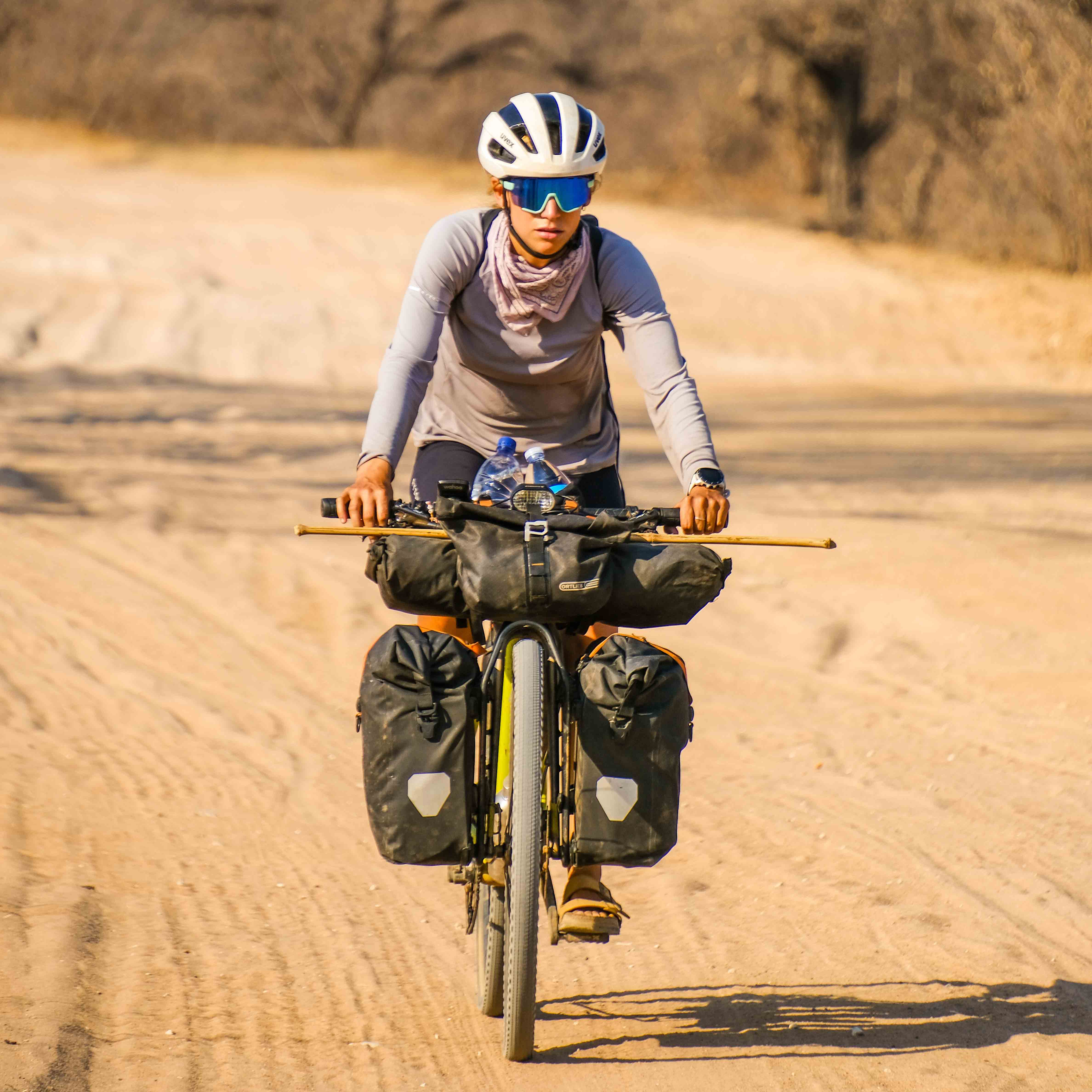
(in case anyone is interested, the stick acts as a bike stand….)
We chatted next about Wiebke’s bike. The first thing that you might have noticed is that she rode a flat bar gravel bike, so that was an obvious starting point for our questions – why did she choose that over a traditional drop bar gravel bike set-up? “My bike is a custom-built Wilier Adlar. In the past I’ve used a standard drop-bar gravel bike, but for this trip I wanted to use a flat bar so that I could carry my tent on the handlebar. Because I was travelling for so long I decided to take a bigger tent, so I wanted an easy way to put this tent in and out of the handlebar pack and therefore the flat bar is more convenient. I thought it might also be more robust. It was also super good from a handling perspective – going up and down on muddy roads, it gave me more control. The bike was set-up with a Shimano XT groupset and was fitted with a 10-51 cassette and a 32 tooth chainring, so even though I was riding a heavily loaded bike I could still get up the steep climbs. It worked out as a really good choice – it was just perfect and it was super reliable. I didn’t have a single puncture (a big shout out to Schwalbe for their amazing tyres). I ran the tyres tubeless and I needed to change them two times because they were worn and I wanted to keep them fresh, but apart from that they were perfect.”
Wiebke mentioned in one of her social media posts that part way through her trip she took the decision to change from a more traditional touring style set-up with rear panniers to a bikepacking-style set-up with more weight on the front and a larger saddle pack. We asked her what inspired this change of set-up? “It was partly about losing some weight because the bigger bags are heavier – just the empty bags probably add up to 1 or 2 kgs extra. I found like I had too much weight on the back of the bike which seemed to be pulling me down on the climbs. Putting more weight on the front seemed to help balance the bike out more. I probably ended up with around 10-15 kg on the front which doesn’t impact my riding skills at all. Of course if you have bigger bags, it’s tempting to take more stuff, so by changing my set-up I was also able to send some stuff home. In total I managed to lose 10 kg from my set-up.“
Wiebke told us a little about her bike set-up was also a conscious decision to make her slow down and appreciate the journey more “For my Norwegian trip I was riding fast, but for the Africa trip I was taking my time and I didn’t want to race it. I had big bags fitted, partly to remind myself that it was not a race. I wore Birkenstock sandals for the pleasure, the fun, the comfort and to remind myself to slow down. I didn’t use clipless pedals. I didn’t use a power meter. I was not even wearing bib shorts.“
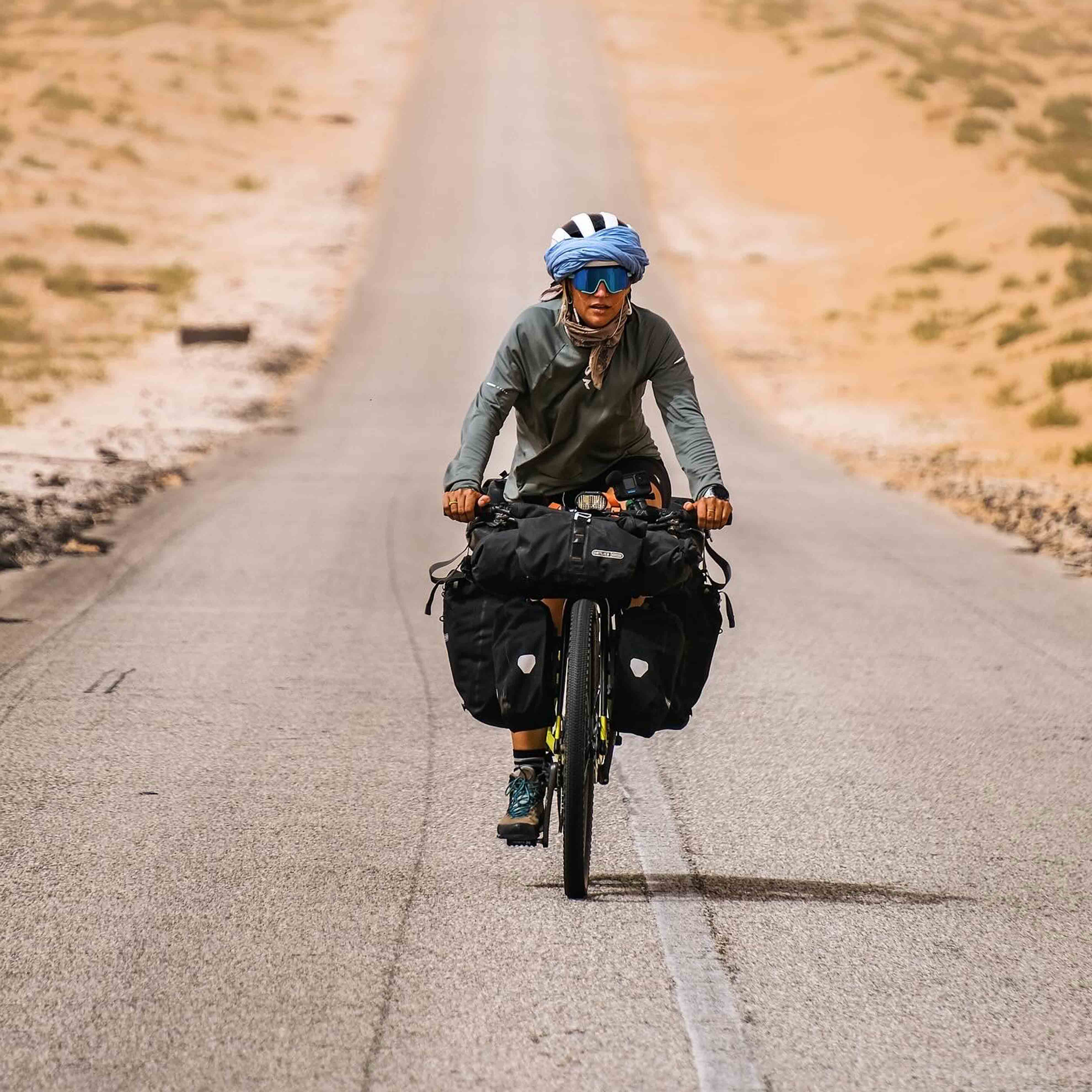
Image courtesy of Julien Soleil
“There is still a long way to go for female sports to get the same kind of media coverage and to be considered in the same league as men.”
If you look back even ten years ago it wasn’t so common to find female bikepackers taking on really challenging trips, whereas now it seems to be more normalised and more women are also seeing as it as career choice. Wiebke has a big following on social media and whether she likes it or not, she is probably a role model to her followers. We asked her whether she had any female role models who really inspired her when she first started and what it felt like to be in the position now where she was the role model instead? “It feels good. I still have my own role models and I also need inspiration from other people, but I’m really happy to share and I’m really happy that people engage with me, they communicate and they ask questions. I’m happy to help and I think it’s amazing to have this platform and to be able to say what I think. It’s a great freedom that I’m able to travel for so long, that I am able to work with brands that allow me to do what I do and it’s a really great privilege. But, there is still a long way to go for female sports to get the same kind of media coverage and to be considered in the same league as men. We are still in the process and I think it’s really cool that people are so aware everywhere now. I would always try to encourage other people, women and men, to go out and explore and to also see the advantage of being a women and not only seeing the disadvantage. I think that will be a real game changer. In a lot of the countries that I travelled through, women don’t have the same rights (or perhaps they only have these rights ‘on paper’). I feel it’s almost my responsibility to talk about this. I think if I had seen more women doing what I do earlier in life, then I would have started earlier too. Maybe I would have ridden in the Tour de France if only I knew……”
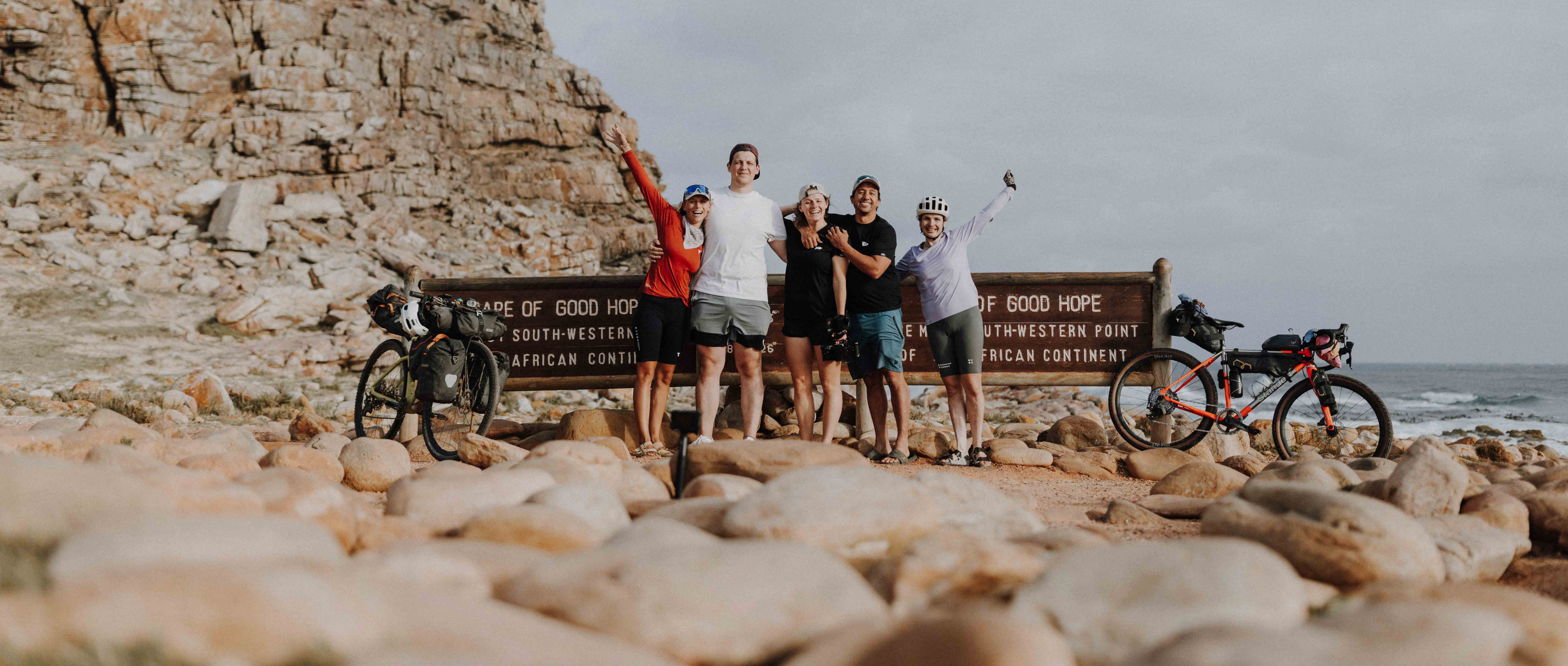
We asked Wiebke what she learned during her amazing journey and she told us “It’s ok to be scared. It’s normal. It’s ok to be scared if you’re doing something for the first time. You don’t have to push it away. I was really trying to push it away, because I thought that people expected me to always be brave and to be strong. But I was scared as well. Now I can also say that I didn’t just lose the weight off my bike, but I lost my fears and my struggles. Now I have a greater trust that everything will work out and if it doesn’t work out, then I can always turn around. If anyone asks for advice now I can say plan less and just start riding and you will see.“
“Sometimes I feel restless and like I don’t fit in anymore, but then I remind myself that it will just take a little time and it’s good to be home”
Our final question was to ask Wiebke about her future plans “I don’t know if I have an answer yet for the long term, but in the short term I’m going to ride the Hamburg to Bordeaux part of the route this spring, probably in May. I would like to make a future bike journey heading east – towards Asia, or the east of Africa. Sometimes I feel restless and like I don’t fit in anymore, but then I remind myself that it will just take a little time and it’s good to be home. I will try and keep the balance between being away and being at home, but perhaps my next trip will be even longer. It all just depends a bit on life and whatever happens in terms of relationships or whatever. I’m really open, but one thing is for sure – I’m definitely going to keep cycling and exploring one way or another!”
If you would like to keep up with Wiebke’s future plans you can find her blog here or follow her on Instagram here.